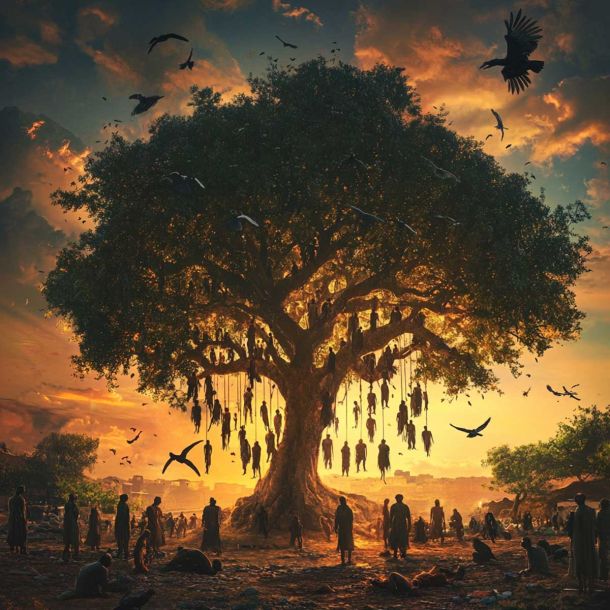MORE COVERAGE
Twitter Coverage
Satyaagrah
Written on
Satyaagrah
Written on
Satyaagrah
Written on
Satyaagrah
Written on
Satyaagrah
Written on
JOIN SATYAAGRAH SOCIAL MEDIA
“By discovering nature, you discover yourself”: Guide Anuradha Rao at Ross Island interacts with Animals, People from all over the world come to witness it, She is also one of the lucky survivors of the tsunami that devastated Andaman & Nicobar in 2004

Anuradha Rao was one of the lucky survivors of the tsunami that devastated the Andaman & Nicobar archipelago in 2004. Alongside the loss of human lives, there was large-scale destruction of pristine jungles, endemic wildlife, and historical sites.
The 500-odd islands, home to several indigenous tribes living deep in the forests, were damaged beyond recognition under the combined onslaught of an earthquake and the gigantic waves that followed it.
Rao recounts how that fateful day began with a bright and beautiful sunrise. “It was 7am and I was seated in my usual boat, all set to sail to Ross Island. I heard a rumbling roar and, before I realised what it was, a massive wave hit the boat. I was flung into the air under the impact, and landed with a thud, completely soaked with sand and seawater. Even before I could recover from this shock, another wave hit even harder and I once again survived the sucker punch. Unfortunately my two brothers died that day, as they were in another boat that had been shattered to pieces. My younger sister, Natasha Rani, too survived the tsunami as she was inland at Port Blair.”
|
Show must go on
At the crack of dawn each day, Rao, a sprightly 55-year-old today, still takes the first boat from Port Blair to Ross Island. She guides and educates tourists on the isolated island, which has several well-preserved ruins dating back to the days of British and Japanese rule in the Andaman Islands. With 37 years of experience behind her, the resident guide earns about ₹10,000 a month during the off-season and double that when the sightseers arrive in droves from October to March.
“I adore this deserted Ross Island, where the Indian navy has discreet operations for the protection of the Andaman Islands. Travellers mostly arrive in the evening to witness the impressive sound-and-light show, so Ross Island is devoid of people the rest of the day, but I never feel lonely. The local birds, squirrels, lizards, feral cats, spotted deer and untamed rabbits keep me company,” she says.
Her favorite creatures are the bulbuls with their melodious calls. Some deer even have names and respond when she calls to them, following her around the island as she lectures to camera-touting tourists. Suddenly she pulls out a baby squirrel from the folds of her dress, where it had been tucked away all this while, and feeds it milk using a syringe. She had rescued the little one after it had fallen from a tree. “I am not married, hence I have adopted these adorable creatures, who give me unconditional love,” she explains.
Even as a child, she preferred to play with rats and cats rather than other children, she says. “When I was seven, my mother once caught me eating mud. She beat me black-and-blue for not spitting it out. Actually I had a tiny baby rat, which was my playmate, hidden in my mouth and my mom was aghast. But she and my dad soon realised that I loved animals more than human beings and indulged me.” Tragically, she lost her father when she was just twelve.
|
‘Paris of the East’
A fourth-generation islander, she proudly recounts how her great-grandfather Krishnaswamy arrived here from Madras years ago. His expertise in woodcraft fetched him a job at the Chatham Saw Mill, an island near Port Blair. The sawmill had been established in the early 1880s to cater to the growing need for wood in the area, as settlements in Port Blair were slowly expanding back then. The British also processed a huge amount of timber for London, New York, and other European cities. Sadly, when the Japanese invaded the island in 1942, they launched an attack on the sawmill, leading to the mass killing of its unsuspecting workers, including Rao’s great-grandfather. “Today his name is etched as one of the martyrs on a plaque at the mill.”
She passionately explains to tourists how Ross Island was once known as the Paris of the East, serving as the British capital of the Andaman Islands. Its grand colonial residences were lavishly furnished. There were barracks, tennis courts, swimming baths, a bazaar with a bakery, and even a desalination plant for freshwater. All of this changed forever following two disasters in quick succession — a mighty earthquake on June 26, 1941, measuring 7.7 on the Richter scale; and the Japanese invasion during World War II. When tragedy struck yet again in the form of the tsunami, Ross Island shrank greatly in size.
Today, vestiges of its colonial glory, such as the Commissioner’s residence, church, powerhouse, printing press, and bakery are all in a dilapidated condition, overgrown with gnarled gigantic roots. “Like this lonely island, I am a loner with my wildlife and unseen Indian navy,” she says. She is practically its unofficial queen, overseeing the birds taking wing under the azure skies and surrounded by the emerald waters.
|
Of virgin beaches and Indian history lessons
Port Blair: Along with its crystal clear blue water, long white sand beaches, mangrove-lined creeks, and diverse marine life, the Andaman and Nicobar Islands also provide visitors with vital insights into Indian history.
The infamous Cellular Jail here — now a museum — stands mute witness to the torture of incarcerated freedom fighters. Completed in 1906, the jail has a seven-pronged, puce-colored building with a central tower acting as its fulcrum and a massive structure comprising honeycomb-like corridors.
It acquired the name cellular because it is entirely made up of individual cells for the solitary confinement of prisoners.
“The light and sound show at the Cellular Jail was very good and aptly covered this vital part of Indian history,” said Akash Jain, a 15-year-old who came to the islands with his family.
The next stop in the history tour is Ross Island, now effectively a suburb of Port Blair and the place where the British had the headquarters of what was their penal colony. The slowly submerging island was originally 200 acres. Now only 70 acres are left above water.
“The island was turned on its knuckles during a massive earthquake and later during the (2004) tsunami. It has ruins of old buildings like a church, ballroom, chief commissioner’s office, cemetery, bakery, swimming pool, printing press and troop barracks. The dilapidated structures supported by overgrown trees are testimony to a bygone era,” the only private guide at the island, Anuradha Rao, told a visiting IANS correspondent.
Rao’s grandfather was born on the island and she loves to walk you through its history.
The lesson is over, you can get back to nature. And for that, the nearby Neil and Havelock islands may be your best bets.
Havelock island, with its beautiful sandy beaches and rich coral beds, is ideal for adventure tourism with facilities for snorkeling and scuba diving available. If you have money to spare, you can even go scuba diving with a trained elephant.
The Radhnagar and Elephanta beaches at Havelock are picturesque, clean, and relatively deserted. Once you had your fill of the sun and the sea, rent a two-wheeler and explore the small island with its amazing and amazingly cheap seafood eateries.
A trip to the Andaman and Nicobar Islands is an experience that not only shows why these are called “emerald islands” but just how far they are from the mainland, physically and mentally.
Physically, as you fly the 1,200-odd km from either Chennai or Kolkata over the Bay of Bengal, the distance to the group of 572 islands is brought home once again. Mentally, the fresh air and the relative lack of people show how far you have traveled from crowded India. Only 36 of the islands are inhabited.
References:
 Support Us
Support Us
Satyagraha was born from the heart of our land, with an undying aim to unveil the true essence of Bharat. It seeks to illuminate the hidden tales of our valiant freedom fighters and the rich chronicles that haven't yet sung their complete melody in the mainstream.
While platforms like NDTV and 'The Wire' effortlessly garner funds under the banner of safeguarding democracy, we at Satyagraha walk a different path. Our strength and resonance come from you. In this journey to weave a stronger Bharat, every little contribution amplifies our voice. Let's come together, contribute as you can, and champion the true spirit of our nation.
 |  |  |
| ICICI Bank of Satyaagrah | Razorpay Bank of Satyaagrah | PayPal Bank of Satyaagrah - For International Payments |
If all above doesn't work, then try the LINK below:
Please share the article on other platforms
DISCLAIMER: The author is solely responsible for the views expressed in this article. The author carries the responsibility for citing and/or licensing of images utilized within the text. The website also frequently uses non-commercial images for representational purposes only in line with the article. We are not responsible for the authenticity of such images. If some images have a copyright issue, we request the person/entity to contact us at satyaagrahindia@gmail.com and we will take the necessary actions to resolve the issue.
Related Articles
- "Where snakes are family, fear sheds its skin": Maharashtra, in Shetpal village cobras roam freely amongst residents, a unique testament to India's deep-rooted harmony with nature, challenging perceptions and captivating visitors with its serpentine charm
- “Birds teach a great life lesson. All you have to do is listen to their song”: Chilika in Odisha is the largest brackish water lake in Asia and great attraction for tourists for fishing, bird watching & boating, indigenous & migratory birds are a delight
- “You can’t make a zebra by painting stripes on a horse”: Deep in the heart of Congo is a curious creature bit like a horse, a bit like a giraffe "Okapi", an artiodactyl mammal that is endemic to Africa, the Okapi is to the Congo what the Panda is to China
- In a heartfelt farewell, Corbett Tiger Reserve Park says goodbye to Gomti, the devoted elephant, and Brandy, the faithful German Shepherd, their retirement tugs at heartstrings, reminding all of the deep bonds formed over years of dedicated service
- "Symbols are powerful because they are the visible signs of invisible realities": Real Sindoor comes from a tree, a low-height tree that finds mention in our scriptures. Seeds from the tree are crushed to make fine powder and were used by Sita and Hanuman
- "There is no index of character so sure as the voice": Pahadi Mayna of Chhattisgarh reproduce an exact pronunciation as humans at times, it begin to learn human speech sounds under social relationships, for bird to talk you must intrude on its social life
- In one of the rarest incidents wild mother elephant gave birth to twins in the Bandipur Tiger Reserve: Soon after the birth, the two toddlers joined their mother back in the herd
- “Someone is sitting in the shade today because someone planted a tree a long time ago”: Great banyan tree in Kolkata's Botanical Garden is world's widest tree with 3600 aerial roots spread in 156000 sqfeet area gives an impression of thick patch of forest
- “An animal’s eyes have the power to speak a great language”: Rare Himalayan Lynx found in Ladakh region of India, they occur throughout northern slopes of Himalayas and has been reported both from thick scrub woodland & barren, rocky areas above tree line
- “If it looks like a duck, quacks like a duck, it's a duck”: Mandarin duck is considered one of the most beautiful birds in the world, this is because of its stunning plumage, which is made up of an array of colors that you can't help but notice them
- "An animal's eyes have the power to speak a great language": Shoebill - large, elusive, stalk-like bird with prehistoric appearance due to oversized shoe-shaped beak, usually silent but clatter their bills loudly during greetings sounds like a machinegun
- “Genius is never understood in its own time”: Do you know when you put your debit card in ATM and ask for money, machine arranges the money before giving it to you using Srinivasa Ramanujan’s partition theory, celebrated as National Mathematics Day
- "Look deep into nature, and then you will understand everything better": Himachal - International Kullu Dussehra Festival, starts with a procession of Lord Raghunath, carried on a Ratha across town, 8000 women perform folk dance wearing traditional outfit
- Former Shia Waqf Board chief Wasim Rizvi reverts to Hinduism at Dasna temple and as a reward Hyderabad Congress leader announced 50 lakh bounty on his head in a viral video
- “True wisdom consists only in the knowledge of Brahman”: Budhanilkantha (Old Blue Throat) Temple, Nepal is a Hindu open air temple dedicated to Mahavishnu, also known as the Narayanan Temple, and can be identified by a large reclining statue of Mahavishnu



























